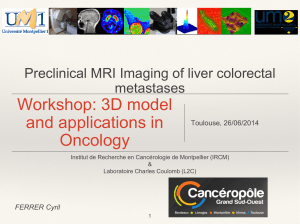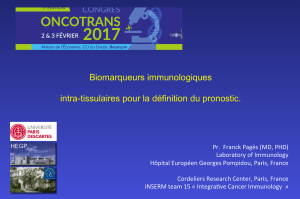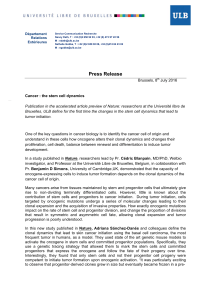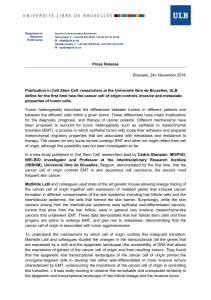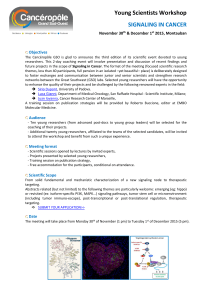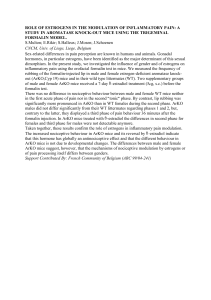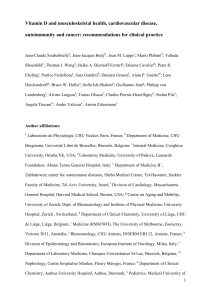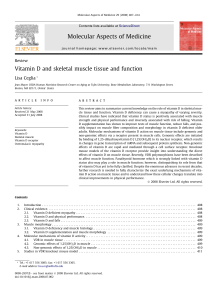Inhibition of the development of metastases by dietary vitamin C:K combination
publicité
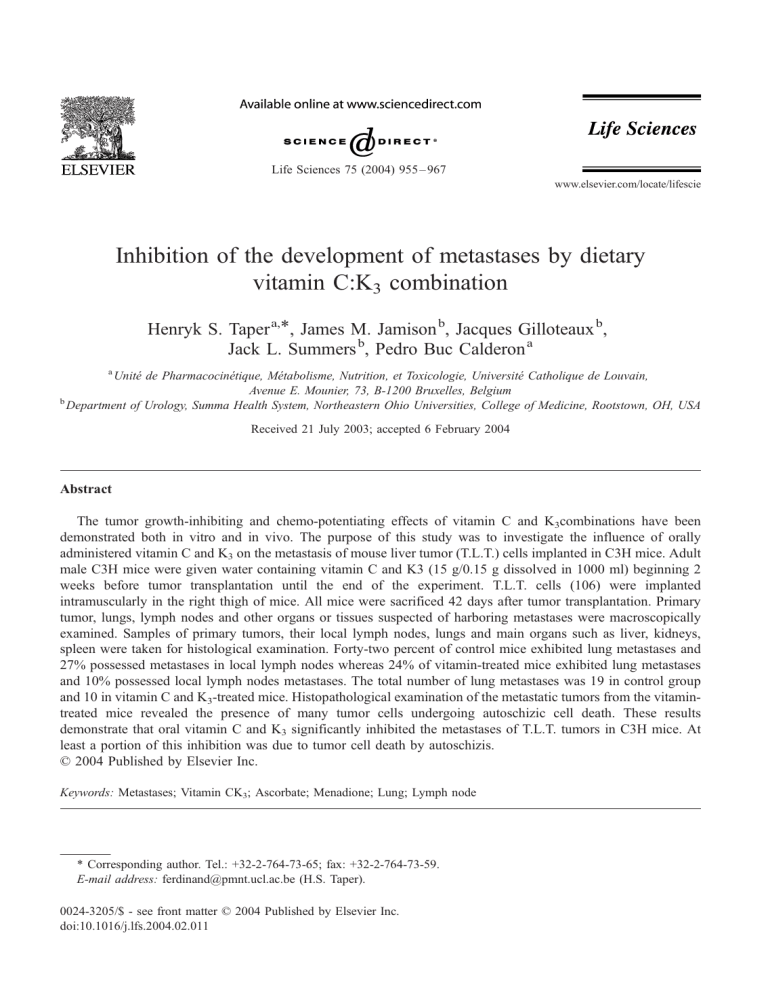
Life Sciences 75 (2004) 955 – 967 www.elsevier.com/locate/lifescie Inhibition of the development of metastases by dietary vitamin C:K3 combination Henryk S. Taper a,*, James M. Jamison b, Jacques Gilloteaux b, Jack L. Summers b, Pedro Buc Calderon a a Unité de Pharmacocinétique, Métabolisme, Nutrition, et Toxicologie, Université Catholique de Louvain, Avenue E. Mounier, 73, B-1200 Bruxelles, Belgium b Department of Urology, Summa Health System, Northeastern Ohio Universities, College of Medicine, Rootstown, OH, USA Received 21 July 2003; accepted 6 February 2004 Abstract The tumor growth-inhibiting and chemo-potentiating effects of vitamin C and K3combinations have been demonstrated both in vitro and in vivo. The purpose of this study was to investigate the influence of orally administered vitamin C and K3 on the metastasis of mouse liver tumor (T.L.T.) cells implanted in C3H mice. Adult male C3H mice were given water containing vitamin C and K3 (15 g/0.15 g dissolved in 1000 ml) beginning 2 weeks before tumor transplantation until the end of the experiment. T.L.T. cells (106) were implanted intramuscularly in the right thigh of mice. All mice were sacrificed 42 days after tumor transplantation. Primary tumor, lungs, lymph nodes and other organs or tissues suspected of harboring metastases were macroscopically examined. Samples of primary tumors, their local lymph nodes, lungs and main organs such as liver, kidneys, spleen were taken for histological examination. Forty-two percent of control mice exhibited lung metastases and 27% possessed metastases in local lymph nodes whereas 24% of vitamin-treated mice exhibited lung metastases and 10% possessed local lymph nodes metastases. The total number of lung metastases was 19 in control group and 10 in vitamin C and K3-treated mice. Histopathological examination of the metastatic tumors from the vitamintreated mice revealed the presence of many tumor cells undergoing autoschizic cell death. These results demonstrate that oral vitamin C and K3 significantly inhibited the metastases of T.L.T. tumors in C3H mice. At least a portion of this inhibition was due to tumor cell death by autoschizis. D 2004 Published by Elsevier Inc. Keywords: Metastases; Vitamin CK3; Ascorbate; Menadione; Lung; Lymph node * Corresponding author. Tel.: +32-2-764-73-65; fax: +32-2-764-73-59. E-mail address: [email protected] (H.S. Taper). 0024-3205/$ - see front matter D 2004 Published by Elsevier Inc. doi:10.1016/j.lfs.2004.02.011 956 H.S. Taper et al. / Life Sciences 75 (2004) 955–967 Introduction The influence of dietary components on tumor growth and development has recently become a subject of major interest (Williams and Dickerson, 1990; Roberfroid, 1991; Milner, 1994). Amongst different alimentary factors, vitamin C and vitamin K3 were investigated as possible antitumor agents (Park et al., 1980; Prasad et al., 1981; Gold, 1986). These vitamins were of particular interest because vitamin C (ascorbic acid or sodium ascorbate) was shown to exclusively reactivate acid DNase (DNase II) in malignant tumor cells, while vitamin K3 (2-methyl-1-4-naphthoquinone) selectively reactivated alkaline DNase (DNase) (Taper, 1980; Taper et al., 2001). These observations were of great interest because previously published studies demonstrated that the activity of alkaline and acid DNases was inhibited in non-necrotic cells of malignant tumors in human and experimental animals as well as during early stages of experimental carcinogenesis (Taper, 1967; Taper et al., 1971a,b; Fort et al., 1974; Taper and Bannasch, 1976). Furthermore, reactivation of alkaline and acid DNase-induced tumor cell death and tumor regression (Taper, 1980; Taper et al., 1981). In fact, the tumor growth-inhibiting and chemotherapy-potentiating effects of vitamin C and K3combinations were evaluated using a variety of human tumor cell lines (Noto et al., 1989; De Loecker et al., 1993). These in vitro studies were extended to a battery of human urologic tumor cell lines, including DU145, an androgen-independent prostate carcinoma cell line (Gilloteaux et al., 1995, 1999; Venugopal et al., 1996a,b; Jamison et al., 1996, 1997, 2001). In these studies, autoschizis, a new type of cell death which differs from necrosis and apoptosis, was described (Gilloteaux et al., 1998, 1999, 2001a,b; Jamison et al., 2001). In vivo administration of the vitamin C and K3 combination to ascites tumor-bearing mice (at a single, intraperitoneal dose of vitamin C = 1g/Kg body weight and vitamin K3 = 0.01 g/Kg) synergistically increased the life span of mice by 45% when compared with sham treated control mice. Individual administration of vitamin C and vitamin K3increased life span by 14% and 1.07%, respectively (Taper et al., 1987). Combined vitamin C and K3 administration also potentiated the chemotherapeutic effects of six different cytotoxic drugs commonly utilized in the classical protocols of human cancer treatment (Taper et al., 1987). The same vitamin C and K3 combination also sensitized a mouse tumor that was resistant to vincristine and potentiated the therapeutic effects of radiotherapy (Taper and Roberfroid, 1992; Taper et al., 1996). More recently, vitamin C administration with a benzoquinone was shown to inhibit the metastasis of several colon cancer cell lines that had been implanted into immunocompetent mice (Hidvégi et al., 1998). The structural similarity of vitamin K3 (a naphthoquinone) to the benzoquinone employed in these studies suggested that the vitamin C and K3 combination may decrease tumor metastasis as well as inhibiting the growth of the primary tumor. Metastases are one of the greatest problems in cancer patients. They appear frequently and are the primary cause of mortality in cancer patients (Fidler, 1999). Different mechanisms are involved in the socalled metastatic cascade, including angiogenesis, cellular adhesion, local proteolysis and tumor cell migration (Kohn, 1993; Fidler, 1999). Development of chemotherapeutic agents which target and intervene in one or more processes in the metastatic cascade should lead to a favorable outcome for a large number of cancer patients. The current study evaluates the ability of orally administered vitamin C and K3 to inhibit the development of metastases of mouse liver tumor (TLT) cells that have been implanted into the thigh of C3H mice. H.S. Taper et al. / Life Sciences 75 (2004) 955–967 957 The TLT cell line is a primary liver tumor of spontaneous origin that was first observed in a 2 month old female Swiss-Webster mouse. The TLT tumor was derived from in vivo passage in mice and characterized by Taper and his colleagues at Sloan Kettering Institute for Cancer Research (Taper et al., 1966). Tumor growth is rapid, invasive and not strain-specific. TLT cells were employed because these tumor cells provide an excellent model for metastasis. Unlike many putative metastatic models in which tumor cells are injected into the tail vein of immunosuppressed rodents and ‘‘metastasize’’ to the lungs, a solid primary tumor is formed in the TLT model. Subsequently, cells from the primary tumor recapitulate all the stages of metastasis. Materials and methods Animals and diets Young adult male C3H mice weighing 25–30 g at the beginning of experiments were purchased from IFFA Credo, Domaine des Oncins, France and were fed basal diet for experimental animals AO4, supplied by U.A.R., Villemoison-sur-Orge, France. Vitamin C (sodium ascorbate) and vitamin K3 (2-methyl-1,4-naphthoquinone) were purchased from Sigma, St. Louis, MO, USA. Control mice received water ad libitum. The mice in the experimental group received vitamin C and K3 (15 g/0.15 g) dissolved in 1000 ml of water. This dose and route of administration of the vitamin C and K3 mixture was shown to produce potent antitumor activity in mice in previous experiments (Taper et al., 1987; Taper and Roberfroid, 1992; Taper et al., 1996) . This mixture of vitamins was prepared each second day and given ad libitum in drinking water beginning 2 weeks before tumor transplantation until the end of the experiment. Tumor transplantation and metastases counting Viable neoplastic cells (106) of a transplantable mouse liver tumor T.L.T. were implanted intramuscularly in the right thigh of C3H mice (Cappucino et al., 1966; Taper et al., 1966). All mice were sacrificed by general anaesthesia when spontaneous mortality appeared (i.e. 42 days after tumor transplantation). After the sacrifice of animals, a detailed general autopsy of each mouse was performed in order to identify the metastases. Primary tumors and all organs or tissues suspected of harboring metastases were macroscopically examined. Samples of primary tumors, their local lymph nodes, lungs and main organs such as liver, kidneys, spleen were taken for detailed histological examination. Special sections up to 10 for each tumor and organ were microscopically examined. Mainly one, the most suspected macroscopically local lymph node per each primary tumor was taken for histological Table 1 Effects of combined vitamin C and K3 given in drinking water on the incidence of lung metastases in male C3H mice bearing intramuscularly transplanted malignant liver tumor (p = 0.06) Group Number of mice with lung metastases per total mice % mice with lung metastases Total number of lung metastases Control Vitamin CK3 14/33 7/29 42% 24% 19 10 958 H.S. Taper et al. / Life Sciences 75 (2004) 955–967 Table 2 Effect of combined vitamin C and K3 given in drinking water on the multiplicity and mean diameter of lung metastases in mice bearing intramuscularly transplanted malignant liver tumor Group Number of cases bearing different numbers of lung metastases per mouse Number of lung metastases with different diameters 0 1 2 3 <100 um 100 – 500 um 500 – 1000 um >1000 um Control Vitamin CK3 19 22 9 5 5 1 0 1 10 7 4 3 4 0 1 0 examination. These samples were fixed in 10% neutral formalin, embedded in paraffin cut into 5–7 Am thick sections with microtome and stained with hematoxylin and eosin. Detailed identification of metastases was performed by a microscale equipped microscope and the number and mean diameter were calculated in all lobes of lungs for each mouse. Identification and counting of possible metastases in other organs was also macro- and microscopically performed. A one tailed z distribution (Tables 1 and 3) and Wilcoxon non-parametric test (Table 2) were utilized for statistical analysis of the results. Results At early stages after tumor transplantation, vitamin C and K3 treatment produced a distinct inhibition of solid and ascitic TLT tumor growth without producing any distinct difference in morphology of treated and control TLT tumors (Taper et al., 1987; Taper and Roberfroid, 1992; Taper et al., 1996). However, the progression of intramuscularly transplanted T.L.T. tumors in C3H mice rapidly became lethal and obliged the sacrifice of all mice 42 days after tumor transplantation. This mortality was accelerated by tumor necrosis, ulcerations and infections. Before the sacrifice, 1 mouse was dead in CK3-treated and 2 in control group. All these spontaneously dead mice were without macroscopically detectable metastases. Due to the advanced post-mortem decomposition, histological examinations were not performed. Between experimental and control groups of mice there were not any difference in water consumption. These primary tumors were voluminous and often exhibited large ulcerations and subsequent dissemination of their contents. Few differences were observed between the tumors in the control and experimental groups at this terminal stage of their evolution. It appeared, that there was not any difference in the number of mitosis in primary tumors and metastases between the control and experimental groups of mice, but they were not counted in this preliminary experiment. However macroscopic and microscopic examination of serial lung sections revealed a distinct difference in the number of mice bearing lung metastases between the control group and the vitamin-treated group. In the experimental group, 7 of 29 mice (24%) exhibited lung metastases. Conversely, in the control group, 15 of 33 mice (42%) possessed lung metastases (Table 1). Similarly, when mice did possess lung metastases, there was a distinct reduction of the total number of lung metastases in the vitamin-treated group as compared with the control group. The total number of lung metastases was 19 in control group and 10 in the vitamintreated group (Table 1). In the majority of mice with lung metastases, there was a single lung metastasis per mouse. Mice with two or more lung metastases were more frequent in control group (5) than in the vitamin-treated group (2) (Table 2). Microscopic evaluation of the diameter of lung metastases demonstrated that the H.S. Taper et al. / Life Sciences 75 (2004) 955–967 959 Table 3 Effect of combined vitamin C and K3 given in drinking water on the Incidence of metastases in local lymph nodes Group Number of metastases in local lymph nodes per total number of examined mice % of mice with lymph nodes metastases Control Vitamin CK3 9/33 3/29 27.2% 10.2% majority of the lung metastases (7 of 10) in the vitamin-treated group exhibited diameters less than 100 Am, while the majority of diameters of the metastases in the control group were greater than 100 Am (range: 100 to 1000 Am). Specifically, 9 of 19 (45%) mice had lung metastases with diameters greater than 100 Am in control group compared to only 3 of 10 (30%) of mice in the vitamin-treated group. Besides the lungs, metastases were found only in local lymph nodes (in the proximity of the implanted primary tumors and in the right retroperitoneal area). Once again, control mice exhibited more metastases than vitamin treated mice (Table 3). In the control group, local lymph node metastases were observed in 9 of the 33 examined mice (27%), whereas in the vitamin-treated group, lymph nodes metastases were found in 3 of 29 examined mice (10.2%). Statistical analysis of the differences in the incidence of metastases between the control and vitamin-treated mice has given Fig. 1. A – D: Histological aspects of small (A – B, i.e. <100 Am diam) and large (C – D) metastatic TLT tumors in mouse lung photographed at low (A and C) and high magnification (B and D). Notice that the small metastasis is circumscribed by a vascular endothelium and shows clusters of tumor cells in its lumen co-aggregated with some rare leukocytes. The large tumor contains a large central necrotic zone where numerous autoschizis and apoptosis are the principle types of cell death are observed. An apoptotic cell displaying nuclear breakdown is indicated by short arrows, while autoschizic nuclei are noted with curved arrows. 960 H.S. Taper et al. / Life Sciences 75 (2004) 955–967 statistically significant results concerning the data presented in Tables 2 and 3 (p<0.05) and closely significant (Table 1, p = 0.06). Detailed autopsies and microscopic examinations did not demonstrate metastases in any other organs besides the lungs and local lymph nodes. In addition, no pathological symptoms or microscopic alterations in tissue or cellular structure was visible in any of the vitamin-treated mice. This apparent lack of toxicity is consistent with the results of previously published studies (Noto et al., 1989; De Loecker et al., 1993; Gilloteaux et al., 1998; Jamison et al., 2001; Buc Calderon et al., 2002; Verrax et al., 2003). Histopathological examination of hematoxylin and eosin stained sections of the lungs of control (Fig. 1) vitamin-treated (Fig. 2) mice reveals several small to large solid tumors. Fig. 1 shows a small (A–B) Fig. 2. A – F: Histological aspects of lung carcinoma and cells in lung tissue of a vitamin treated C3H mouse. The scale in A is 250 Am and 10 Am B to F. In A: An example of a small carcinomatic solid tumor metastasis from a TLT tumor. B – C: Higher magnification views of aggregated cells show cell pleiomorphism and several apoptotic nuclei (arrows) in the peripheral (B) and central (C) zone of the treated tumor. Throughout the fields of view, nuclei display large to enormous oblong nucleoli. In some cells, the chromatin appears as thick stripes or as a reticulated aspect along the nuclear envelope. These are an early phase of nuclear damage which leads to autoschizic cell death. D: Open arrows indicate the reticulated nuclear chromatin of many cells in the peripheral zones of the solid tumor. E: This example illustrates ongoing cytoplasmic excision (curved arrows) among cells with vacuolated cytoplasm. F: In large areas of the solid metastatic tumor, cells appear significantly smaller than the typical tumor cells while the nuclei still display a large, central compact nucleolus (i.e. open arrowheads) with delicate, rimmed chromatin and poor contrast. All of these morphological characteristics are characteristics of the process of autoschizic cell death. H.S. Taper et al. / Life Sciences 75 (2004) 955–967 961 and a large (C–D) metastatic TLT tumor in mouse lung photographed at low (A and C) and high magnification (B and D). The small metastasis is circumscribed by a vascular endothelium and shows clusters of tumor cells in its lumen which are co-aggregated with some rare leukocytes. While the large tumor contains a large central necrotic zone, autoschizis and apoptosis are the principle types of cell death observed outside this zone. Fig. 3. This figure shows a local lymph node taken from an untreated mouse (A – D) and a local lymph node taken from a VC:VK3 treated mouse (E – I). A: A general view of the lymph node shows the collections of metastatic cells in the subcapsular sinus and mantle zone of the perilymphoid space which exhibit a glassy pink-orange contrast after H&E staining. B – D: A higher magnification of the same lymph node depicts a few metastatic cells including some that are undergoing mitosis. In E: A general view of a region of a vitamin-treated lymph node which is equivalent to the region shown in Fig. A reveals many open spaces (open arrows) due to the dramatic reduction in the size of the metastatic cells. F – I: Higher magnification of the same lymph node demonstrates the presence of many apoptotic cells (small arrows) and autoschizic cells (curved arrows). The open arrows indicate large pieces of excised cytoplasm among smaller nuclei which are greatly reduced in size and are indicative of autoschizis. The scales are 10 Am for all micrographs in this figure. 962 H.S. Taper et al. / Life Sciences 75 (2004) 955–967 Upon initial examination, the peripheral zone of the tumors display the pleiomorphism that is characteristic of tumor cells (Fig. 3). However, at higher magnifications, one can see carcinoma cells with large nuclear/cytoplasmic ratios, indented nuclei as well as several small apoptotic cells, apoptotic bodies and autoschizic cells (Fig. 1B–D). Autoschizis is a novel type of cell death which is characterized by exaggerated membrane damage and the progressive loss of cytoplasm through a series of selfexcisions. These self-excisions typically continue until the perikaryon consists of an apparently intact, round nucleus surrounded by a thin rim of cytoplasm which contains damaged organelles. During the process of cell death by autoschizis, nucleoplasms initially become more chromatic and then progressively lose chromaticity as their size decreases. Concomitant with this diminution in cell size, the nuclei become smaller and contain large nucleoli which become round and compact (Fig. 2F). Therefore, before it dies, the size of the resultant autoschizic cell is much smaller than the tumor cell from which it originated (Gilloteaux et al., 1998, 1999, 2001a,b). Cells in both the central and peripheral zones of the tumors display morphologic characteristics representative of various stages of autoschizic cell death (Fig. 2B–F). First, there is a decrease in nuclear indentation and a concomitant development of compact spherical nuclei. Second, the nuclei display round to oblong compacted nucleoli which occupy a large volume of the nucleoplasm. Third, the degraded chromatin gives the nucleoplasm a reticulated or striped pattern (Fig. 2C and D). Fourth, the perikarya decrease their size through selfexcisions of cytoplasmic pieces (Fig. 2E). Fifth, the size of the cells is greatly reduced while the nucleoli appear compact to fragmented in a nucleoplasm with greatly decreased contrast (Fig. 2A, E and F). Histopathological examination of hematoxylin and eosin stained sections of local lymph nodes taken from control and vitamin-treated C3H mice reveal an interesting phenomenon. The subcapsular sinus of the control lymph node is clogged with many metastatic TLT cells. These cells can be distinguished from the lymphocytes by their larger size and by the pink-orange color of their cytoplasm. As is the case for the tumor cells in vitamin-treated lung metastases, the tumor cells in the vitamin-treated lymph node appear to be undergoing both apoptosis and autoschizis with autoschizis being the most prominent form of tumor cell death. The incidence of autoschizis seems to be more prevalent in the lymph nodes than in the lung metastases. Discussion The results of the current study demonstrated that oral administration of vitamin C and K3 produced a distinct inhibitory effect on the development of metastases in C3H mice bearing an intramuscularly transplanted mouse liver tumor. Detailed microscopic examination of the main organs as well as the lungs and local lymph nodes (other tissues known to harbor metastases from this tumor) revealed a distinct inhibitory effect of oral vitamin treatment on the development of metastases. As was the case in previous experiments, oral ad libitum administration of clinically attainable doses of vitamin C and K3 in drinking water did not produce any adverse symptoms in the mice or macroscopic/microscopic pathological alterations in the organs and tissues examined during this study (Taper et al., 1987, 1996, 2001; Taper and Roberfroid, 1992). Both direct antitumor and immunomodulatory effects are among the different mechanisms that may be involved in the therapeutic and antimetastatic effects of the vitamin combination. The antitumor effects of vitamin C are related to the ability of the VC to induce a G1 block in the cell cycle as well as the ability of the VC to redox cycle (Saitoh et al., 1997; Vojdani et al., 2000). This cycling process H.S. Taper et al. / Life Sciences 75 (2004) 955–967 963 generates intracellular H2O2 and other reactive oxygen species (ROS) that deplete cellular thiol levels, initiate membrane lipid peroxidation and result in tumor cell death. A concomitant reactivation of DNase II occurs during the redox cycling process and leads to the degradation of tumor cell DNA (Taper, 1980; Taper et al., 2001). In addition, enrichment of intracellular ascorbate content of tumor cells following the addition of exogenous vitamin C has been shown to inhibit tumor metastasis and invasion by inducing a marked decrease in metalloproteases (MMP) 2 and 9 via a post-transcriptional inhibition of MMP proenzyme production (Nagao et al., 2000). As was the case for VC, the antitumor effects of vitamin K3 are a function of the vitamins ability to block the cell cycle, to stimulate redox cycle and to reactivate DNase I. VK3binds to the catalytic domain of Cdc25 phophatase which results in the formation of an inactive hyperphosphorylated Cdk1. VK3 also inhibits cyclin E expression at late G1 phase and cyclin A expression at the G1/S transition. Together these effects cause cell cycle arrest and can lead to tumor cell death (Wu and Sun, 1999). Administration of VK3 is also known to induce a variety of effects on cells including: reduction of nicotinamide adenine dinucleotide phosphate and adenosine triphosphate pools; depletion of glutathione; induction of singlestranded DNA breaks; and oxidation of sulfhydryl groups in cytoskeletal proteins (Gant et al., 1988; Mirabelli et al., 1989). A concomitant reactivation of DNase I occurs during the redox cycling process and leads to the degradation of tumor cell DNA (Taper, 1980; Taper et al., 2001). When VC and VK3 are combined in a VC: VK3 ratio of 100:1, the combination exhibits tumor specific antitumor activity. The potentiation and specificity of the cytotoxic antitumor activity has been attributed to the ability of intracellular redox cycling of the VC and VK3 to cogenerate the long-lived ascorbyl and semiquinone free radicals as well as other ROS; to generate peroxides which induce membrane lipid alteration, and to reactivate both DNase I and DNase II which destroy DNA (Noto et al., 1989; Taper and Roberfroid, 1992; De Laurenzi et al., 1995). The importance of sequential DNase I and II reactivation to the in vivo antitumor activity of the vitamin combination has been demonstrated histochemically in both the TLT model and in a system in which human androgen-independent prostate cancer cells were implanted in nude mice. In these studies, loss of tumor cell DNA content and the incidence of tumor cell death by autoschizis were well correlated with the reactivation of tumor cell DNases (Taper, 1980; Taper et al., 2001). While various mechanisms have been proposed to account for the antitumor properties of vitamin Cquinone combinations, no evidence has been presented to explain adequately the preferential attack on the primary tumor cells or their metastases, as opposed to normal cells (Morgan et al., 1998). It has been suggested that the selective toxicity of the vitamin combination in tumor cells may be due to reduced levels of catalase, superoxide dismutase and/or glutathione peroxidase as well as other ROS detoxifying enzymes in these cells which leads to cellular damage through the accumulation of hydrogen peroxide and other ROS (Noto et al., 1989; Benade et al., 1969; Josephy et al., 1978). Supression of the antitumor activity of the vitamin combination by simultaneous administration of catalase supports this hypothesis (Noto et al., 1989; Taper and Roberfroid, 1992). It has also been suggested that the selectivity of the vitamins to tumor cells may be related to their preferential accumulation in these cells. The results of in vitro and in vivo studies demonstrate that VC exhibits selective toxicity towards malignant melanoma cells, human leukemia cells, neuroblastoma cells, tumor ascites cells and other malignant cell lines that has been ascribed, at least in part, to their preferential accumulation in tumor cells (Prasad et al., 1979; Bram et al., 1980; Park et al., 1980; Liotti et al., 1984). Likewise, VK3 and its derivatives have been shown to preferentially accumulate in the tumors of rodents inoculated with Walker rat carcinoma 256 or Ehrlich mouse ascites cells. Furthermore, VK3 and its derivatives have been employed as radio- 964 H.S. Taper et al. / Life Sciences 75 (2004) 955–967 sensitizers because of their ability to concentrate selectively in malignant cells of certain human tumors and their metastases (including liver, kidney, bladder, prostate, stomach, intestine and colon cancers) while exhibiting minimal accumulation in bone marrow (Marrian et al., 1969; Halsall et al., 1973). Finally, the selectivity of the antitumor response has been attributed to the immunostimulatory properties of the vitamin combination. A variety of mechanisms have been proposed for this immunostimulation including: modulation of CD4+ T-lymphocyte helper activity, induction and increased production of interferon, and activation of the JAK-STAT pathway (Dahl and Degre, 1976; Askarkhodzhaev et al., 1979; Terekhova et al., 1991; Rybnikov et al., 1997; Hidvégi et al., 1998; Markovits et al., 1998; Morgan et al., 1998; Simon et al., 1998; Dong et al., 1999; Slaton et al., 1999; Bystrova et al., 2000). It is obvious from the preceding discussion that the VC/VK3 combination exerts its antitumor and antimetastatic activities through a wide array of mechanisms including: blockage of the cell cycle, stimulation of redox cycling, induction of autoschizic cell death, reactivation of DNases, decreasing MMP activity and potentiating the immune system. Additional investigations are necessary to elucidate the importance of each of these mechanisms in the antitumor and antimetastatic activities of the vitamin C/K3 combination. Acknowledgements The authors thank Dr. J. Cumps for statistical analysis, Mrs. R.M. Dujardin for very competent technical assistance and Mrs. E. Ferdinand for careful typing of the manuscripts. References Askarkhodzhaev, N.A., Tazulakhova, E.B., Ershov, F.I., 1979. Stimulation of interferon production. Antibiotiki 24, 669 – 672. Benade, L., Howard, T., Burk, D., 1969. Synergistic killing of Ehrlich ascites carcinoma cells by ascorbate and 3-amino-2,2,4triazole. Oncology 23, 33 – 43. Bram, S., Froussard, P., Guichard, M., Jasmin, C., Augery, Y., Sinoussi-Barre, F., Wray, W., 1980. Vitamin C preferential toxicity for malignant melanoma cells. Nature (London) 284, 629 – 631. Buc Calderon, P., Cadrobbi, J., Marques, C., Hong-Ngoc, N., Jamison, J.M., Gilloteaux, J., Summers, J.L., Taper, H.S., 2002. Potential therapeutic application of the association of vitamins C and K3 in cancer treatment. Current Medicinal Chemistry 9, 2269 – 2285. Bystrova, N.A., Brovkina, I.L., Prokopenko, L.G., Uteshev, B.S., 2000. Immunomodulating effects of vitamin K preparations and its potentiation by riboxine in acute cold stress. Eksperimentalnaia i Klinicheskaia Farmakologiia 63, 50 – 53. Cappucino, J.G., Brown, G.F., Mountain, S.M., Spencer, S., Tarnowski, G.S., 1966. Chemotherapeutic studies on new transplantable mouse liver tumor (Taper liver tumor). Cancer Research 26, 689 – 694. Dahl, H., Degre, M., 1976. The effect of ascorbic acid production on human interferon and the antiviral activity in vitro. Acta Pathologica Microbiologica Scandinavica [B] 84B, 280 – 284. De Laurenzi, V., Melino, G., Savini, I., Annicchiarico-Petruzzelli, M., Finazzi-Agrò, A., Avigliano, L., 1995. Cell death by oxidative stress and ascorbic acid regeneration in human neuroectodermal cell lines. European Journal of Cancer 31, 463 – 466. De Loecker, W., Janssens, J., Bonte, J., Taper, H.S., 1993. Effects of sodium ascorbate (vitamin C) and 2-methyl-1,4-naphthoquinone (vitamin K3) treatment on human tumor cell growth in vitro. II. Synergism with combined chemotherapy action. Anticancer Research 13, 103 – 106. Dong, Z., Greene, G., Pettaway, C., Dinney, C.P.N., Bue, I., Lu, W., Bucana, C.D., Balbay, M.D., Bielenberg, D., Fidler, I.J., 1999. Suppression of angiogenesis, tumorigenicity, and metastasis by human prostate cancer cells engineered to produce interferon-h. Cancer Research 59, 872 – 879. H.S. Taper et al. / Life Sciences 75 (2004) 955–967 965 Fidler, I.J., 1999. Critical determinants of cancer metastasis: rationale for therapy. Cancer Chemotherapy Pharmacology 43, S3 – S10. Fort, L., Taper, H.S., Brucher, J.M., 1974. Gastric carcinogenesis induced in rats by methylnitrosourea (MNU). Morphology and histochemistry of nucleases. Zeitschrift fur Krebsforschung und Klinische Onkologie 81 (1), 51 – 62. Gant, T.W., Rao, D.N., Mason, R., Cohen, G.M., 1988. Redox cycling and sulphydryl arylation; their relative importance in the mechanism of quinone cytoxicity to isolated hepatocytes. Chemico Biological Interactions 65, 157 – 173. Gilloteaux, J., Jamison, J.M., Venugopal, M., Giammar, D., Summers, J.L., 1995. Scanning electronmicroscopy and transmission electron microscopy aspects of synergistic antitumor activity of vitamin C-vitamin K3 combinations against human prostatic carcinoma cell. Scanning Microscopy International 9, 159 – 173. Gilloteaux, J., Jamison, J.M., Arnold, D., Ervin, E., Docherty, J.J., Neal, D., Summers, J.L., 1998. Cancer cell necrosis by autoschizis. Synergism of antitumor activity of vitamin C: vitamin K3 on human bladder carcinoma T24 cells. Scanning 20, 564 – 575. Gilloteaux, J., Jamison, J.M., Arnold, D., Taper, H.S., Summers, J.L., 1999. Autoschizis: another cell death for cancer cells facilitated by vitamins C and K3 treatment. Molecular Biology of the Cell 10, 44a. Gilloteaux, J., Jamison, J.M., Arnold, D., Summers, J.L., 2001a. Autoschizis: another cell death for cancer cells induced by oxidative stress. In: Motta, P.M., Machiarelli, G., Nottola, S.A. (Eds.), Advances in Microanatomy of Cells and Tissues. Italian Journal of Anatomy and Embryology, vol. 106 (suppl. 1), pp. 79 – 91. Gilloteaux, J., Jamison, J.M., Arnold, D., Taper, H.S., Summers, J.L., 2001b. Ultrastructural aspects of autoschizis: A new cancer cell death induced by the synergistic action of ascorbate/menadione on human bladder carcinoma cells. Ultrastructal Pathology 25, 183 – 192. Gold, J., 1986. In vivo synergy of vitamin K3 and methotrexate in tumor bearing animals. Cancer Treatment Reports 70, 1433 – 1435. Halsall, G.M., Connolly, J.G., Mobbs, B.G., Promislow, C., 1973. Synkavit. Radiosensitizing agent in prostate carcinoma. Urology 1, 550 – 552. Hidvégi, M., Raso, E., Tomoskozi-Farkas, R., Paku, S., Lapis, K., Szende, B., 1998. Effect of avemar and avemar + vitamin C on tumor growth and metastasis in experimental animals. Anticancer Research 18, 2253 – 2258. Jamison, J.M., Gilloteaux, J., Venugopal, M., Koch, J.A., Shah, R., Summers, J.L., 1996. Flow cytometric and ultrastructural aspects of the synergistic antitumor activity of vitamin C-vitamin K3 combinations against human prostate carcinoma cells. Tissue and Cell 28, 687 – 701. Jamison, J.M., Gilloteaux, J., Koch, J.A., Nicastro, E., Docherty, J.J., Hoke, J., Sowick, C., Summers, J.L., 1997. Vitamin C and K3-induced oxidative stress in human prostate tumor cells: mitochondrial ultrastructural alterations. Microscopy and Microanalysis 3 (suppl. 2), 23 – 24. Jamison, J.M., Gilloteaux, J., Taper, H.S., Summers, J.L., 2001. Evaluation of the in vitro and in vivo antitumor activities of vitamin C and K3 combinations against human prostate cancer. Journal of Nutrition 131, 158S – 160S. Josephy, P.D., Palcic, B., Skarsgard, L.D., 1978. Ascorbate-enhanced cytotoxicity of misonidazole. Nature (London) 271, 370 – 372. Kohn, E.C., 1993. Development and prevention of metastasis. Anticancer Research 13, 2553 – 2560. Liotti, F.S., Menghini, A.R., Guerrieri, P., Talsea, V., Bodo, M., 1984. Effects of ascorbic acid and dehydroascorbic acid on the multiplication of tumor ascites cells in vitro. Journal of Cancer Research and Clinical Oncology 108, 230 – 232. Markovits, J., Sun, T.P., Juan, C.C., Ju, G.C., Wu, F.Y.H., 1998. Menadione (vitamin K3) enhances the mitogenic signal of epidermal growth factor via extracellular signal-regulated kinases. International Journal of Oncology 13, 1163 – 1170. Marrian, D.H., Mitchell, J.S., Bull, C.H., King, E.A., Szaz, K.F., 1969. Labelled compound related to synkavit and its uptake in certain human tumours studied by radio-isotope scanning. Acta radiologica: Therapy, Physics, Biology 8, 221 – 246. Milner, J.A., 1994. Reducing the risk of cancer. In: Goldberg, A. (Ed.), Functional Food. Chapman and Hall, New York, pp. 39 – 70. Mirabelli, F., Salis, A., Vairetti, M., Bellomo, G., Thor, H., Orrenius, S., 1989. Cytoskeletal alterations in human platelets exposed to oxidative stress are mediated by oxidative and Ca2+-dependent mechanisms. Archives of Biochemistry and Biophysics 270, 478 – 488. Morgan, C.D., Lefkowitz, S.S., Everse, J., 1998. Synergism of dimethoxybenzosemiquinone free radicals and CD4+ Tlymphocytes to suppress Ehrlich ascites tumor. Proceedings of the Society for Experimental Biology and Medicine 217, 89 – 96. 966 H.S. Taper et al. / Life Sciences 75 (2004) 955–967 Nagao, N., Nakayama, T., Etoh, T., Saiki, I., Miwa, N., 2000. Tumor invasion is inhibited by phosphorylated ascorbate via enrichment of intracellular vitamin C and decreasing oxidative stress. Journal of Cancer Research and Clinical Oncology 126, 511 – 518. Noto, V., Taper, H.S., Yi-Hua, J., Janssens, J., Bonte, J., De Loecker, W., 1989. Effects of sodium ascorbate (vitamin C) and 2methyl-1,4-naphthoquinone (vitamin K3) treatment on human tumor cell growth in vitro. Cancer 63, 901 – 906. Park, C.H., Amare, M., Savin, M.A., Hoogstraten, B., 1980. Growth suppression of human leukemic cells in vitro by Lascorbic acid. Cancer Research 40, 1062 – 1065. Prasad, K.N., Edwards-Prasad, J., Sakomoto, A., 1981. Vitamin K3 (menadione) inhibits the growth of mammalian tumor cells in culture. Life Sciences 29, 1387 – 1392. Prasad, K.N., Sinha, P.K., Ramanujam, M., Sakamoto, A., 1979. Sodium ascorbate potentiates the growth inhibitory effect of certain agents on neuroblastoma cell in culture. Proceedings of the National Academy of Sciences, USA 76, 829 – 832. Roberfroid, M.B., 1991. Dietary modulation of experimental neoplastic development: role of fat and fiber content and caloric intake. Mutation Research 259, 351 – 362. Rybnikov, V.N., Laskova, I.L., Prokopenko, L.G., 1997. Naphthoquinones as immunomodulators during intensive exertion. Antibiotiki i Khimioterapiia 42, 6 – 10. Saitoh, Y., Nagao, N., Uchida, O.R., Yamane, T., Kageyama, K., Muto, N., Miwa, N., 1997. Moderately controlled transport of ascorbate into aortic endothelial cells against slowdown of the cell cycle, decreasing of the concentration or increasing of coexistent glucose as compared with dehydroascorbate. Molecular and Cellular Biochemistry 173, 43 – 50. Simon, A.R., Rai, U., Fanburg, B.L., Cochran, B.H., 1998. Activation of the JAK-STAT pathway by reactive oxygen species. American Journal of Physiology 275, C1640 – C1652. Slaton, J.W., Perrotte, P., Inoue, K., Dinney, C.P.N., Fidler, I.J., 1999. Interferon-a-mediated down-regulation of angiogenesisrelated genes and therapy of bladder cancer are dependent on optimization of biological dose and schedule. Clinical Cancer Research 5, 2726 – 2734. Taper, H.S., Wooley, G.W., Teller, M.N., Lardis, M.P., 1966. A new transplantable mouse liver tumor of spontaneous origin. Cancer Research 26, 143 – 148. Taper, H.S., 1967. L’activité des nucléases et phosphatases acides et alcalines dans les tumeurs rénales induites chez le rat par la diméthylnitrosamine (étude histochimique). Pathologia Europea 2, 406 – 420. Taper, H.S., Fort, L., Brucher, J.M., 1971a. Histochemical activity of alkaline and acid nucleases in rat parenchyma during Nnitrosomorpholine carcinogensis. Cancer Research 31, 913 – 916. Taper, H.S., Brucher, J.M., Fort, L., 1971b. Alkaline and acid nucleases activity in the tumors of the human central nervous system (histochemical study). Cancer 28, 482 – 490. Taper, H.S., Bannasch, P., 1976. Histochemical correlation between glycogen, nucleic acids and nucleases in preneoplastic lesions of rat liver short-term administration of N-nitrosomorpholine. Zeitschrift für Krebsforschung und Klinische Onkologie 87, 53 – 65. Taper, H.S., 1980. Reversibility of acid and alkaline deoxyribonuclease deficiency in malignant tumor cells. Journal of Histochemistry and Cytochemistry 29, 1053 – 1060. Taper, H.S., Deckers, C.O., Deckers-Passau, L.O., 1981. Increase in nuclease activity as a possible means for detecting tumor cell sensitivity to anticancer agents. Cancer 47, 523 – 529. Taper, H.S., de Gerlache, J., Lans, M., Roberfroid, M., 1987. Non-toxic potentiation of cancer chemotherapy by combined vitamin C and K3 pretreatment. International Journal of Cancer 40, 575 – 579. Taper, H.S., Roberfroid, M., 1992. Non-toxic sensitization of cancer chemotherapy by combined vitamin C and K3 pretreatment in a mouse tumor resistant to Oncovin. Anticancer Research 12, 1651 – 1654. Taper, H.S., Keyeux, A., Roberfroid, M., 1996. Potentiation of radiotherapy by nontoxic pretreatment with combined vitamin C and K3 in mice bearing solid, transplantable tumor. Anticancer Research 16, 499 – 504. Taper, H.S., Jamison, J.M., Gilloteaux, J., Gwin, C.A., Gordon, T., Summers, J.L., 2001. In vivo reactivation of DNases in implanted human prostate tumors after administration of vitamin C/K3 combination. Journal of Histochemistry Cytochemistry 49, 109 – 119. Terekhova, N.V., Nikolaeva, I.S., Il’ina, M.T., Fomina, A.N., 1991. The interferon-inducing and immunomodulating action of bonafton in chronic diseases of the oral mucosa. Stomatologiia 6, 21 – 22. Venugopal, M., Jamison, J.M., Gilloteaux, J., Koch, J.A., Summers, M., Giammar, D.M., Sowick, C., Summers, J.L., 1996. Synergistic antitumor activity of vitamin C and K3 on human urologic tumor cell lines. Life Sciences 59, 1389 – 1400. Venugopal, M., Jamison, J.M., Gilloteaux, J., Koch, J.A., Summers, M., Hoke, J., Sowick, C., Summers, J.L., 1996. H.S. Taper et al. / Life Sciences 75 (2004) 955–967 967 Synergistic antitumor activity of vitamin C and K3 against human prostate carcinoma cell lines. Cell Biology International 20, 787 – 797. Verrax, J., Cadrobbi, J., Delvaux, M., Jamison, J.M., Gilloteaux, J., Summers, J.L., Taper, H.S., Buc Calderon, P., 2003. Vitamins C and K3 kills cancer cells mainly by autoschizis, a novel form of cell death. Basis for their potential use as coadjuvants in anticancer therapy. European Journal of Medicinal Chemistry 38 (5), 451 – 457. Vojdani, A., Bazargan, M., Vojdani, E., Wright, J., 2000. New evidence for antioxidant properties of vitamin C. Cancer Detection and Prevention 24, 508 – 523. Williams, C.M., Dickerson, J.W., 1990. Nutrition and cancer. Some biochemical mechanisms. Nutrition Research Reviews 3, 45 – 100. Wu, F.Y.H., Sun, T.-P., 1999. Vitamin K3 induces cell cycle arrest and cell death by inhibiting Cdc25 phosphatase. British Journal of Cancer 35, 1388 – 1393.



